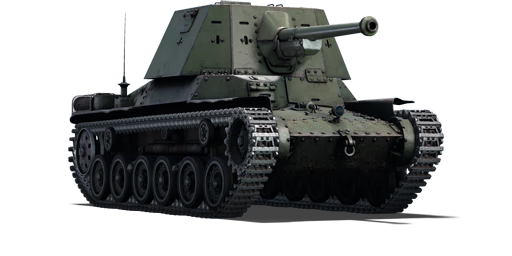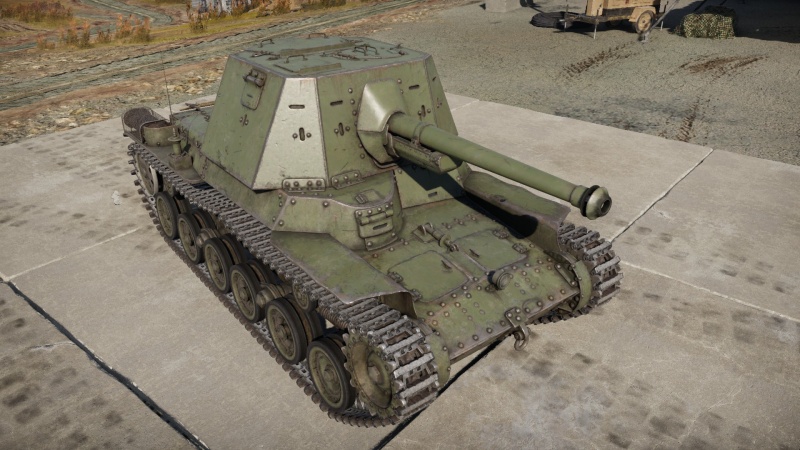Ho-Ni III
| This page is about the Japanese tank destroyer Ho-Ni III. For the other vehicle of similar name, see Ho-Ni I. |
Contents
Description
The Type 3 Ho-Ni III (三式砲戦車「ホニIII」) was a tank destroyer developed by Japan during World War II. It was equipped with a Type 3 75 mm tank gun, which had a high muzzle velocity and could penetrate the armour of US tanks. Unlike its predecessors, the Ho-Ni III had a fully enclosed and armoured casemate that provided protection to the crew from ground and aerial threats. The vehicle was designed to supplement the newer Type 3 Chi-Nu tanks by converting the obsolete Type 97 Chi-Ha hulls into self-propelled guns. The production of the Ho-Ni III started in 1944, but only 31 units were completed due to material shortages and bombing. Most of these vehicles were stationed in the Japanese home islands and never saw combat.
The Ho-Ni III was introduced along with the initial Japanese ground tree in Update 1.65 "Way of the Samurai". It is similar to the Type 1 Ho-Ni I, but improved: more crew members, a shorter reload time, and armour for the gun crew. However this comes at the cost of a lower top speed. The gun has high penetration and damage, so enemies can be easily sniped from afar. The armour is weak and most enemies can pierce it easily. Help allies by giving fire support, and use smoke shells to create temporary cover.
General info
Survivability and armour
Having 25 mm of armour coverage around the entire gun crew, the Ho-Ni III no longer needs to fear artillery shrapnel or strafing runs from fighter aircraft. Do note however that it's still vulnerable to bombs, rockets and direct artillery hits! However, if the Ho-Ni III takes a hit, likely to survive with more operational crewmembers, as three of them must be knocked out before the vehicle becomes inoperable.
Another small armour increase is seen on the front of the tank, with the driver and radio station protected with another 10 mm of armour, though with this added strength, it still leaves an undesirable total width of a lacking 35 mm.
Armour type:
- Rolled homogeneous armour
| Armour | Front | Sides | Rear | Roof |
|---|---|---|---|---|
| Hull | 25 mm (12-31°) Front plate 17 mm (80-81°) Front glacis 15 mm (63°) Joint plate 15 mm (37-59°) Lower glacis |
25 mm (40°) Top Left 20 mm (24-27°) Top Right 20 mm Bottom |
17 mm (69°) Top 20 mm (4-58°) Bottom |
12 mm |
| Superstructure | 25 mm (15-16°) Front 25 mm (3-47°) Gun mantlet |
25 mm (24-26°) | 25 mm (10-11°) | 10 mm |
Notes:
- Suspension wheels and tracks are both 15 mm thick.
- Driver's port on the front plate is 10 mm thick.
- An extra 10 mm of armour is plated on top of the bow machine gun area, left from the driver's position.
Mobility
| Game Mode | Max Speed (km/h) | Weight (tons) | Engine power (horsepower) | Power-to-weight ratio (hp/ton) | |||
|---|---|---|---|---|---|---|---|
| Forward | Reverse | Stock | Upgraded | Stock | Upgraded | ||
| Arcade | Expression error: Unexpected * operator. | 241 | Expression error: Unexpected round operator. | __.__ | |||
| Realistic | 150 | Expression error: Unexpected round operator. | __.__ | ||||
The only drawback of the Ho-Ni III compared to its previous version, is that the tank has a slight decrease in top speed. On flat terrain, it reaches a top speed of 32 km/h, compared to the Ho-Ni I's top speed of 36 km/h.
Modifications and economy
Armaments
Main armament
The Ho-Ni III features a modernized Type 3 75 mm tank gun, based on the 75 mm Type 90 field gun as on the previous Ho-Ni I, still being a great cannon, even with a slightly higher battle rating. With the addition of two dedicated loaders in a fully closed casemate, the gun also gets almost a second cut down on its reload time, making it capable of even more destruction.
| 75 mm Type 3 | Turret rotation speed (°/s) | Reloading rate (seconds) | |||||||||||
|---|---|---|---|---|---|---|---|---|---|---|---|---|---|
| Mode | Capacity | Vertical | Horizontal | Stabilizer | Stock | Upgraded | Full | Expert | Aced | Stock | Full | Expert | Aced |
| Arcade | 46 | -10°/+20° | ±10° | N/A | 14.09 | 19.50 | 23.68 | 26.20 | 27.86 | 7.15 | 6.33 | 5.80 | 5.50 |
| Realistic | 9.52 | 11.20 | 13.60 | 15.04 | 16.00 | ||||||||
Ammunition
| Penetration statistics | |||||||
|---|---|---|---|---|---|---|---|
| Ammunition | Type of warhead |
Penetration @ 0° Angle of Attack (mm) | |||||
| 10 m | 100 m | 500 m | 1,000 m | 1,500 m | 2,000 m | ||
| Type 1 APHE | APHE | 103 | 101 | 92 | 82 | 73 | 65 |
| Type 94 HE | HE | 12 | 12 | 12 | 12 | 12 | 12 |
| Shell details | ||||||||||||
|---|---|---|---|---|---|---|---|---|---|---|---|---|
| Ammunition | Type of warhead |
Velocity (m/s) |
Projectile mass (kg) |
Fuse delay (m) |
Fuse sensitivity (mm) |
Explosive mass (TNT equivalent) (g) |
Ricochet | |||||
| 0% | 50% | 100% | ||||||||||
| Type 1 APHE | APHE | 668 | 6.56 | 1.3 | 15 | 84.8 | 47° | 60° | 65° | |||
| Type 94 HE | HE | 522 | 6.02 | 0 | 0.1 | 810 | 79° | 80° | 81° | |||
| Smoke shell characteristics | ||||||
|---|---|---|---|---|---|---|
| Ammunition | Velocity (m/s) |
Projectile mass (kg) |
Screen radius (m) |
Screen deploy time (s) |
Screen hold time (s) |
Explosive mass (TNT equivalent) (g) |
| Type 90 Smoke | 570 | 5.72 | 13 | 5 | 20 | 100 |
Ammo racks

| Full ammo |
1st rack empty |
2nd rack empty |
3rd rack empty |
4th rack empty |
5th rack empty |
Visual discrepancy |
|---|---|---|---|---|---|---|
| 46 | 44 (+2) | 40 (+6) | 36 (+10) | 23 (+23) | 0 (+46) | No |
Notes:
- Racks disappear after you've fired all shells in the rack.
- Turret flanks empty: 36 (+10) shells
Usage in battles
The Ho-Ni III plays very similar to the Ho-Ni I with the added benefit of two extra crew which cuts down on the reload time for the 75 mm gun.
The starting Japanese player will also be quite accustomed to the handling of the hull, as it still is based on the Chi-Ha. But due to the added weight of the fully enclosed casemate, it is slower compared to its brother Chi-Ha.
With the added benefit of the casemate and crew, the Ho-Ni III sports better survivability, though, most shells will not knock you out in one shot due to having a total of five crew members. The crew isn't out in the open anymore and has sufficient armour from machine-gun fire from both ground & air enemies. Knowing this, you can stand to take more chances of sitting in one location and not have to worry about aircraft making a single pass and taking the vehicle out.
Pros and cons
Pros:
- Effective 75 mm gun with APHE can penetrate all enemies at its rank
- The -10° of gun depression allows the Ho-Ni III to shoot from the cover of ridgelines or downwards from an elevated position
- Fully enclosed crew compartment provides better protection from strafing aircraft
- Five-man crew allows three members to be knocked out and still allows the tank to function
- Has access to smoke shells which can help hide yourself or blind an enemy
Cons:
- The thin armour makes the vehicle less effective in close-quarters engagements
- Four of the crew are close together leaving them vulnerable to being knocked out by a single shot
- Having no machine gun, the Ho-Ni III will have difficulty to disable vehicles without armour like the GAZ-MM (72-K)
- Limited traverse of the gun forces you to turn the vehicle to cover wider fields of fire
History
The Type 3 Ho-Ni III is a self-propelled anti-tank artillery gun. The Ho-Ni III was the third of the Japanese 'tank destroyers', which Japan developed based on inspiration from the German tanks of this class. This SPG was very similar to the previous models of this series, the Ho-Ni I and Ho-Ni II, but surpassed them in multiple ways, embodying all the very best of each of them. The chassis of the medium Type 97 Chi-Ha Kai tank was used as a base, while the Ho-Ni I and II used a simple, unmodernized version of the Type 97 Chi-Ha. The powerful 75 mm Type 90 field cannon was chosen as a gun. In its design, this was a counterpart of the French 85 mm Schneider cannon (85 mle 1927 Schneider). After a small redesign for installation on the tank, this gun was designated the Type 3. The cannon was installed in an armoured non-rotating superstructure which, in contrast to the Ho-Ni I and Ho-Ni II, was fully enclosed on all sides and provided optimal protection for the crew. Additional ammo took the place of the machine gun in the hull, and the SPG's crew was reduced to four (in comparison to the five of the previous vehicles in this series).
Ho-Ni series SPGs went into production in 1942, and the order to design and produce the upgraded Ho-Ni III was received by the Hitachi firm in the beginning of 1944. Due to a shortage of resources and constant bombings, the Japanese industry was only able to produce roughly 35 Ho-Ni III SPGs before the end of the war. Most of them were distributed among divisions tasked with defending Japan itself, while only a few were sent to areas of active military operations such as Okinawa and the Philippines. No records survive of military clashes between the Ho-Ni III and American tanks.
- From Devblog
Media
- Skins
See also
- Related Development
- Other vehicles of similar configuration and role
External links
| Hitachi, Ltd. (株式会社日立製作所) | |
|---|---|
| SPG | Ho-Ni I · Ho-Ni III |
| Japan tank destroyers | |
|---|---|
| Ro-Go Derivatives | Ro-Go Exp. |
| Chi-Ha Derivatives | Ho-Ni I · Ho-Ni III · Ho-Ro · Chi-Ha LG |
| Ho-Ri | Ho-Ri Prototype · Ho-Ri Production |
| Other | Na-To |
| JGSDF | |
| SPRG | Type 60 (C) |
| SPH | Type 75 · Type 99 |
| ATGM | Type 60 ATM |
| Rocket | Type 75 MLRS |
| USA | ▅M36 |






